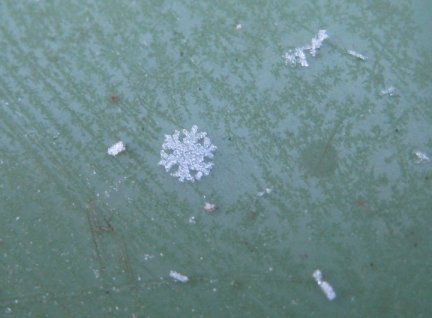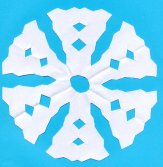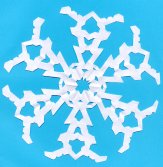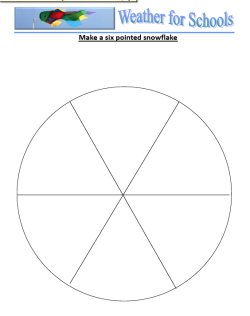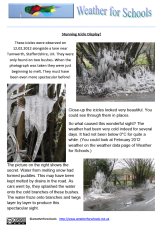Below Freezing
When it gets colder that 0°C the temperature numbers are represented by a minus number. If the temperature goes down 4°C from 0 it will be -4°C (minus 4°C). If the temperature drops 5 degrees from 2°C the temperature will be -3°C. Think of it as a number line and count on or back when the temperature goes up or down.
It is even more fun that when the temperature drops below 0°C water will freeze (at sea level). This can produce all sort of interesting sights around us. Some of these are illustrated below. If you want to catch some of these on camera, take lots of photographs. It can be hard to get the camera to focus on the right bit, so try a variety of settings and keep reviewing your images. Don't forget that you could use the close-up setting (macro).
When you have finished reading about this you may want to return to Collecting Data, go back to the Temperature page or visit More About Temperature Readings. If you want warming up, you could go to Sunshine!
FrostFrost is made up of frozen water which has not turned into a liquid. It goes straight from water vapour to ice. Water vapour can freeze into beautiful crystals, which can grow on a variety of surfaces. In the image on the right frost has formed on a bird table making a beautiful pattern. |
 |
HoarfrostHoarfrost forms when the temperature is well below freezing. It can produce beautiful needles of ice. It can look quite white because of the reflective properties of the water crystals. |
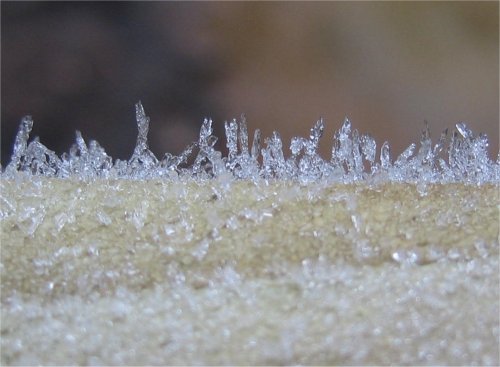 |
Ice LoopsThese strange loops of ice joined the twigs on a bush in really cold weather. It had been foggy. This ice may be an example of something called glaze, which is clear and hard. |
 |
Iced DandelionThis dandelion seed head has been turned into a wonderful sight. Look at the ice on it. After reading the information above would you say that this is frost or glaze? You can see some art work using this photograph on the General Interest page. |
 |
IciclesIf ice or snow thaws and then freezes again there may be icicles. Those on the right stayed for a couple of days as the temperature did not go above 0°C to make the ice melt.They can get much bigger than this, but this is a pretty photograph of them. |
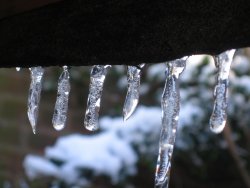 |
Masses of IciclesSometimes icicles are found in a very unusual form. There were two whole bushes found covered in icicles on 12th February 2012 near Tamworth, UK (look at the weather summary on the Data page after the end of February to see what the weather had been like.) Other nearby bushes were not covered in ice. Click here to have a closer look at one of the icicles. What could have caused it? If you are stuck click here to see another picture which gives much more of a clue. Do you give up? Answer here! |
 |
HailHail is made up of spheres of ice formed as they travel up and down inside a cumulonimbus clouds. The ice is formed in layers. They can get very large, and can cause a lot of damage. They can destroy fields of crops. Most hailstones are pea sized, but they have been know to be considerably larger. It can be painful to get caught outside in a hailstorm. Nobody ventured out to the car when the hailstorm in the picture suddenly started. |
|
SnowSnow is a small word for a large subject. There are many different sorts of snow. It can cause lots of problems when a large quantity of it falls and does not melt. Many countries have special vehicles to help clear away the snow. Gritters can also put down salt to try and stop it settling. Vehicles can find it very hard to move on snow. This man is clearing the snow on a drive so that vehicles can get to the road. Click on the picture to see a larger image. You will then be able to see animal tracks in the snow too. See more pictures of snow here. |
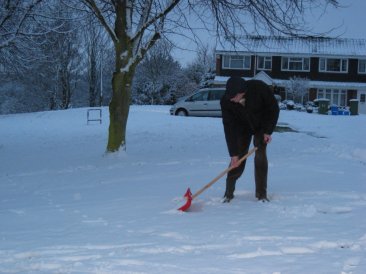 |
Snow VisibilityWhen it snows very heavily it can make it very difficult to see very far. In the video clip the snow is falling heavily and the houses in the distance cannot be seen clearly. When the snow is being blown by a strong wind, and the snow is heavy it is called a blizzard. |
|
SnowflakesSnowflakes are based on a hexagon shape. It is not often that you get a chance to see this with the naked eye. The snowflake in the picture was spotted on a frosty bin lid. It was about 1cm across. Next time it should be photographed with a ruler to give it scale. It was very hard to make the camera focus on the snowflake. See some snowflake activities in the files section. |
|
GraupelGraupel looks quite similar to hail, but it has snow inside it. Ice has frozen in a coating round the snow. The snow inside it makes this precipitation look whiter. This graupel fell on a old February morning in Staffordshire UK. It lasted until the sun came out when it quickly melted and dried up. Click here to see how a bush stopped the graupel falling on one part of a path. This reminds you of the importance of putting your rain gauge away from obstructions. |
 |
Icy Roads and footpathsWhen there is lying water or dampness in the air ice can form on the ground. This can be very dangerous on the roads and on footpaths. A mixture containing salt can be put down. Salt water freezes at a lower temperature. The salt can therefore stop ice from forming, or help ice to thaw. |
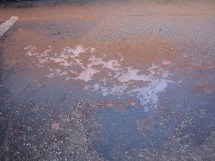 |
IceIt can be quite a shock to see the water frozen over. This is especially the case if it is a large lake or a waterfall which usually splashes on its way. It is very hard to say how deep the ice is, it may be quite thin. It's always best to be safe and observe it from a distance.It has to be even colder for the sea to freeze. Why is that? On the right a large freshwater lake has frozen. See More About Clouds to remind yourself what it is called when the sun shines through the clouds like this. |
 |
Using ICTSensors are used to tell workers when the temperature is falling below 0°C so that they need to put grit on the roads to stop ice from forming on them. They often need to to this in the night when it gets very cold. If you wanted a similar warning some remote temperatures have alarms which can be set to sound at a particular temperature. You would then know if it is likely to be icy outside. |
Please Note
Remember you cannot tell how thick, or thin, the ice on frozen water is. Don't venture out on it. Anybody falling through the ice could die in the cold water.

